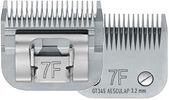Choosing the Right Clippers and Blades for Grooming
- Jul 14
- 4 min read
Updated: Aug 6
Grooming is an essential part of pet care, and choosing the right tools can make all the difference. One of the most important decisions you'll make is selecting clippers and blades. This guide will dive into the different types of clippers and blades available, tips for making the ideal selection, and how to maintain your tools for optimal performance.

Understanding the Right Clippers and Blades
Before you make a choice, it's vital to understand the types of clippers and blades available. Clippers are motorised tools used for cutting hair, while blades come in various sizes and materials for different hair types and cutting lengths.
Types of Clippers
Traditional Clippers: These are often heavier and designed for professional use. They have a powerful motor suitable for thick fur.
Cordless Clippers: These offer flexibility and movement without getting tangled. They are ideal for at-home grooming sessions.
Trimmers: Generally smaller and lighter, trimmers are perfect for touch-ups around sensitive areas like ears and paws.

Types of Blade Lengths
Understanding blade size lengths is also crucial. Each blade size corresponds to a specific hair length:
Size 10: Leaves hair 1/16 inch long, ideal for close cuts.
Size 7F: Leaves hair about 1/8 inch long, great for general grooming.
Size 4F: Leaves hair about 1/4 inch long, suitable for longer haircuts.
Blades can also be made from different materials, such as stainless steel or chrome-plated, which can affect durability and performance.

Factors to Consider When Choosing Clippers and Blades
When you begin selecting clippers and blades, keep in mind several key factors that can influence your decision.
Hair Type
The type of hair your pet or the animal you are grooming has will dictate the kind of clippers and blades you should choose. For example:
Thick or Curly Hair: Requires a powerful clipper and sharper blades.
Fine or Short Hair: May need lighter clippers with smoother blades for a gentle cut.
Motor Power
The motor's strength in clippers can affect performance. Look for clippers with adjustable speeds to handle various hair types efficiently. Typically, clippers with a high RPM (revolutions per minute) will cut through thick fur more easily, minimising tugging and discomfort for the pet.
Noise Level
If your pet is anxious, consider purchasing quieter clippers. These can help ease their stress during the grooming process. Many brands highlight this feature, so be sure to check product details.
Pricing and Quality
Not all clippers and blades are created equal – price often correlates with quality. It's common to see entry-level clippers priced less, but this may compromise durability and effectiveness over time.
Budget Tips for Buying Clippers and Blades
If you are on a budget, you can still find quality tools:
Do Your Research: Compare products and read reviews.
Buy Sets: Purchasing a complete set that includes both clippers and blades can be more economical. The Clipit Quattro Cordless Clipper Set is ideal, as it includes a clipper, a set of attachment combs with a holdall grooming bag.
Consider Used Tools: Ensure they are in good condition, and clean thoroughly before using them.

Maintenance and Care for Clippers and Blades
Once you've selected the right tools, maintaining them is crucial for lasting performance.
Cleaning Your Clipper Blades
Daily Cleaning: Brush off hair after use.
Deep Cleaning: Use blade wash every few weeks. DO NOT clean with water and washing-up liquid. This will cause corrosion.
Lubrication: Apply clipper oil to the blades every 5-10 minutes for smooth operation, which reduces wear. The best oil for this is Clipit Easy Oil Spray. Renowned for it's effectiveness for keeping blades cool
Blade Sharpening
At Clipit, we understand that maintaining sharp, reliable tools is crucial for effective clipping. That’s why we offer expert sharpening and servicing for both clipper blades and scissors, ensuring your equipment performs at its best. Regular care not only extends the lifespan of your tools but also ensures safe, efficient grooming for pets.
For tips on how to properly care for your clipper blades, visit our dedicated Blade Care page. Trust us to keep your tools in top condition, so you can focus on delivering the best grooming results for your clients.
Over time, blades will dull, affecting performance.
Sharpening Kits: Invest in a blade sharpening kit or hire a professional to ensure your clippers cut efficiently.
Replacement: Know when to replace blades. If they constantly tug or pull on hair, it’s time for new ones.
Choosing the right clippers and blades for grooming is essential for a smooth process and happy pets. By understanding the types and features available, considering your budget, and maintaining your tools effectively, you can create a pleasant grooming experience for both you and your pet.











Comments